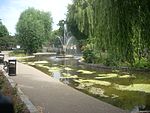Hackney Downs (ward)
2002 establishments in EnglandWards of the London Borough of Hackney
Hackney Downs is a ward in the London Borough of Hackney, corresponding roughly to the Hackney Downs area of London, UK and forms part of the Hackney North and Stoke Newington constituency. It was created for the May 2002 local election. There was previously a Downs ward from 1965 to 1978.
Excerpt from the Wikipedia article Hackney Downs (ward) (License: CC BY-SA 3.0, Authors).Hackney Downs (ward)
Midhurst Way, London Clapton (London Borough of Hackney)
Geographical coordinates (GPS) Address Nearby Places Show on map
Geographical coordinates (GPS)
| Latitude | Longitude |
|---|---|
| N 51.556 ° | E -0.063 ° |
Address
Midhurst Way
Midhurst Way
E5 8PS London, Clapton (London Borough of Hackney)
England, United Kingdom
Open on Google Maps





